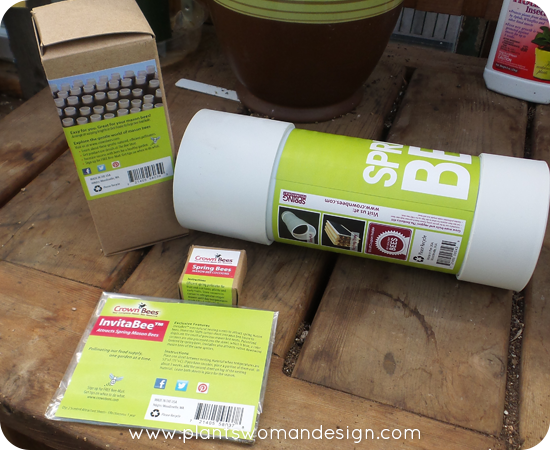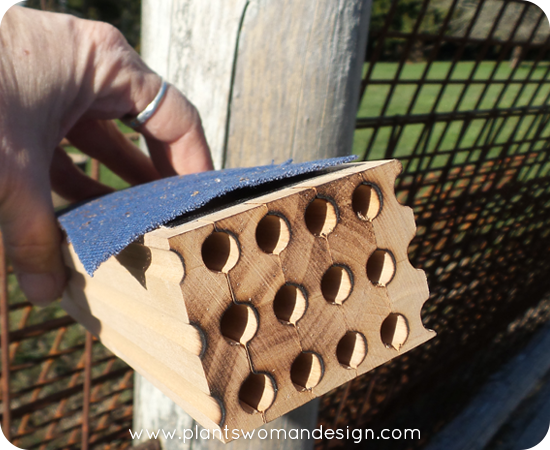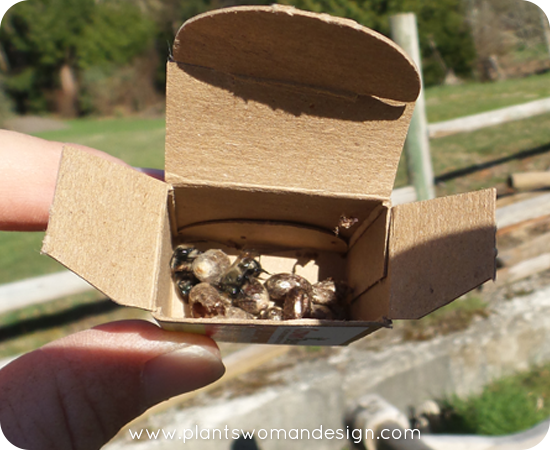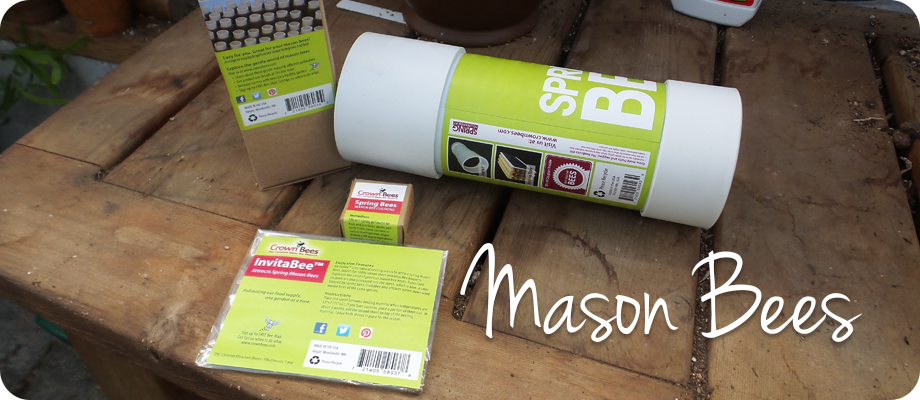Back in February we wrote about Mason Bees and the tremendous job they do pollinating the garden. With our warm weather starting early this year I purchased my kit from my local nursery, Valley Nursery, two weeks ago. The guidelines say to wait until it is 53 degrees and warming in the daytime. It has been getting up to 58 – 59 in the daytime and yesterday was even warmer so I’m going to put my bees out.
 This is the Crown Bee Kit I purchased. The bees come separate so you can get more If needed. I had a hard time deciding where to put the nesting box. It needed to be where the sun would hit it early in the day to warm them, not near predators (birds mostly), and within 300 feet of a mud/water source. Wanting to see them in action I placed it on a post at eye level next to my vegetable garden plot behind the green house. Mason bees need a ready food source (something blooming) when they emerge. The espaliered fruit trees are almost ready to bloom so they will be available for early food for the bees along with the Forsythia, hellebores, and Indian plum (oemleria cerasiformis) blooming now.
This is the Crown Bee Kit I purchased. The bees come separate so you can get more If needed. I had a hard time deciding where to put the nesting box. It needed to be where the sun would hit it early in the day to warm them, not near predators (birds mostly), and within 300 feet of a mud/water source. Wanting to see them in action I placed it on a post at eye level next to my vegetable garden plot behind the green house. Mason bees need a ready food source (something blooming) when they emerge. The espaliered fruit trees are almost ready to bloom so they will be available for early food for the bees along with the Forsythia, hellebores, and Indian plum (oemleria cerasiformis) blooming now.
 Following the directions, I placed the lid on the post and used screws to attach it. I left the top screw out a little and tightened the bottom one so there was a little slant. This helps to protect the home from rain. However, the downward slant can’t be too great or the block of nesting holes will fall out.When the tube was attached , I took off the clear plastic cover, slid the block inside and put the bee attractant, which helps the bees find their home when they first emerge, on the top.
Following the directions, I placed the lid on the post and used screws to attach it. I left the top screw out a little and tightened the bottom one so there was a little slant. This helps to protect the home from rain. However, the downward slant can’t be too great or the block of nesting holes will fall out.When the tube was attached , I took off the clear plastic cover, slid the block inside and put the bee attractant, which helps the bees find their home when they first emerge, on the top.
 When I opened the box of bees, it was so exciting to see that a couple of the bees had already emerged from their cocoon! I could see them sleeping in there.
When I opened the box of bees, it was so exciting to see that a couple of the bees had already emerged from their cocoon! I could see them sleeping in there.
 I placed the box near the opening so as they emerged they would see the nesting box. When I checked the next day I saw two bees flying around the box.
I placed the box near the opening so as they emerged they would see the nesting box. When I checked the next day I saw two bees flying around the box.
I want to build another box this weekend and try out the straws I bought. Straws are an alternative nesting material for mason bees that are disposable. When the season is over, the straws are taken apart to harvest the bee cocoons. The box I have now can be taken apart and cleaned after harvesting the new bee cocoons. The instructions recommend taking the cocoons out in the fall and storing them inside a refrigerator or cold shed until spring arrives to start the process again. Removing the cocoons and storing them protects them from predators in the winter.
Are you jumping into Mason Bees with us? We want to hear about it! Leave a comment below or follow us on Facebook.


